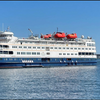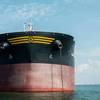Mariners calling on the Port of New York/New Jersey will now have a new tool to assist them navigate safely through the harbor. The Port of
New York/New Jersey Operational Forecast System (NYOFS), created by the NOAA National Ocean Service's (NOAA Oceans and Coasts) Center for
Operational Oceanographic Products and Services (CO-OPs), provides
mariners, port managers and spill response teams with present and future
water levels and current conditions. NOAA Oceans and Coasts is an agency
of the Commerce Department's National Oceanic and Atmospheric
Administration (NOAA).
NYOFS nowcast (for present conditions) and forecast (for future
conditions) products are generated by a three dimensional hydrodynamic
model that uses information including real-time water-level and wind data,
to predict water levels and currents at thousands of locations throughout
the Port of New York/New Jersey. The NYOFS suite of products include data
plots, and animations of water levels and currents. NYFOS nowcast and
forecast products will assist port managers and shippers in making
decisions regarding maximum tonnage (based on bottom clearances) and
limiting passage times, without compromising safety.
The system is run in both nowcast and forecast modes. The nowcast
mode performs hourly updates and is driven by real-time water levels and
winds from the New York/New Jersey Harbor Physical Oceanographic Real-Time
System (PORTS(r)). The forecast model performs 30-hour forecasts, four
times a day. Primary inputs for this mode include initialization from the
nowcast model, tidal harmonics and forecast guidance of subtidal water
levels and winds obtained from operational NOAA National Weather Service
numerical models.
In addition to the NYFOS, NOAA Oceans and Coasts also developed
and maintains the Chesapeake Bay Operations Forecast System
(CBOFS). Another system is also under development for Galveston Bay and
the Port of Houston.
CO-OPS collects, analyzes and distributes historical and real-time
observations and predictions of water levels, coastal currents and other
meteorological and oceanographic data. The Center manages the National
Water Level Program, the national network of PORTS(r) in major U.S.
harbors, and the National Current Program.
Sponsored Content
MSC Sets a New Standard for Time Off in 2025, Plus Earn a $38,340 Bonus as an Able Seaman!

Navigate Compliance with Confidence: Discover Carbon Diligence from ABS Wavesight

Featured videos

Xenos Marine Takes Aim at the Gulf Salvage, Decommissioning Markets

AI to the Rescue: Zelim’s ZOE to be Installed on Cruise Ship
Subscribe for
Maritime Reporter E-News
Maritime Reporter E-News is the maritime industry's largest circulation and most authoritative ENews Service, delivered to your Email five times per week











